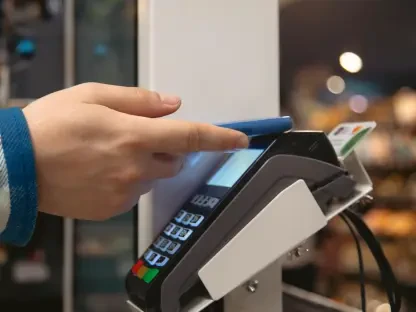The retail landscape has undergone a seismic shift, driven by the pandemic and rapid advancements in digital technology. Consumers have moved from traditional in-person shopping to a blend of online and in-store experiences, creating new challenges and opportunities for merchants. This article delves into the concept of unified commerce and its potential to shape the future of retail in a digital-first world.
The Evolution of Consumer Shopping Behaviors
From Active Pursuit to Passive Shopping
In the past, shopping was an active pursuit that required effort and planning, often involving trips to the mall. Today, consumers have adopted a more passive approach, seamlessly integrating shopping into their daily lives through digital channels. This shift has been accelerated by the pandemic, which forced many to rely on online shopping for their needs. This passive shopping behavior marks an evolution in consumer habits that emphasizes convenience and efficiency over the traditional, leisurely window-shopping experience.
The traditional model entailed dedicated shopping trips, whether prompted by necessity or the desire for leisure activities. However, the advent of e-commerce and mobile technology has revolutionized how consumers interact with retail. They now engage in shopping while multitasking—whether during a commute, work break, or even while socializing. This change has necessitated a transformation in the strategies devised by merchants and retailers, who must now innovate continuously to align with this shift and cater to the new consumer expectations effectively.
The Rise of Mobile-First Experiences
Mobile devices have become central to the shopping experience, with consumers expecting seamless interactions across various channels. This trend has led to the rise of mobile-first payment solutions, which allow shoppers to make purchases effortlessly, whether online or in-store. Merchants must adapt to this new reality by offering integrated, mobile-friendly payment options. This is not merely an option but a necessity, as contemporary consumers view mobile capabilities as a basic expectation rather than a luxury.
Mobile-first experiences offer unparalleled convenience and flexibility, enabling consumers to transition between browsing and purchasing seamlessly. For merchants, recognizing the importance of mobile optimization is critical. It requires an investment in user-friendly mobile interfaces, streamlined payment gateways, and responsive customer service. By doing so, businesses can facilitate a frictionless shopping experience that meets the demands of tech-savvy consumers, thus maintaining competitiveness in an ever-evolving retail landscape.
The Challenges Faced by Merchants
Integrating Point Solutions and New Technologies
Merchants are struggling to keep up with the rapid pace of technological advancements. Many are attempting to integrate multiple point solutions and new technologies to meet consumer demands. However, this can create friction and deter customers if not executed properly. The key is to find a balance that enhances the shopping experience without overwhelming the consumer. This balancing act involves a thoughtful integration of technologies that not only work well independently but also contribute to a cohesive and streamlined shopping journey.
The challenge is magnified by the diversity of consumer preferences and behaviors, requiring merchants to adopt flexible and adaptable solutions. Merchants must sift through an array of technological options, each promising to revolutionize the retail experience. They must then select, implement, and integrate these technologies cohesively. Missteps in this process can lead to fragmented experiences that frustrate customers and erode brand loyalty, highlighting the critical role of strategic planning and the careful selection of tech solutions.
Competing for Fragmented Consumer Attention
In a digital-first world, consumers’ attention is increasingly fragmented. Merchants are not only competing against each other but also against a myriad of digital distractions. To capture and retain consumer attention, businesses must offer compelling and seamless shopping experiences that stand out in a crowded marketplace. This complexity requires more than just innovative products or attractive marketing; it involves creating engaging, user-centered experiences that offer real value.
Crafting these experiences entails a deep understanding of consumer behavior and preferences. Leveraging data analytics, merchants can gain insights into shopping patterns, preferences, and pain points, enabling them to tailor their offerings accordingly. By focusing on personalized, frictionless shopping journeys, merchants can capture consumer attention amid digital noise. This approach requires a commitment to continuous improvement and innovation, ensuring that the retail experience evolves in tandem with shifting consumer expectations and technological advancements.
The Need for a Unified Commerce Approach
Building a Robust Infrastructure
A unified commerce approach requires a robust infrastructure that can support seamless interactions across all shopping channels. This involves creating a single point of integration and utilizing APIs to ensure a fluid consumer experience. Approximately 60% of merchants currently lack the necessary technology to cater to mobile-first shoppers, highlighting the urgent need for infrastructure investment. A solid infrastructure forms the backbone of unified commerce, enabling consistent and efficient experiences across various consumer touchpoints.
Building this infrastructure requires an initial investment and sustained commitment to technological upgrades. It involves integrating backend systems, from inventory management to payment processing, allowing them to communicate seamlessly. This is pivotal for facilitating real-time updates and transactions that enhance the consumer experience. By creating a cohesive technological base, merchants can ensure that their physical and digital channels work in harmony, reducing friction and enhancing overall efficiency.
Enhancing Customer Relationships with Preferred Payment Methods
Preferred payment methods play a crucial role in enhancing customer relationships. According to the survey, 75% of consumers consider preferred payment methods pivotal to their shopping experience. By offering these options, merchants can communicate more effectively with customers, anticipate their needs, and foster loyalty. Providing a variety of payment solutions not only meets consumer expectations but also builds trust and satisfaction, crucial components of long-term customer relationships.
Merchants who prioritize customer preferences in payment methods demonstrate responsiveness and respect for consumer needs. This responsiveness not only improves the immediate shopping experience but also builds a foundation for sustained engagement and loyalty. Preferred payment methods act as touchpoints of customer-centric service, reinforcing brand loyalty and encouraging repeat business. This strategic alignment with consumer preferences is a clear pathway to maintaining competitiveness and fostering lasting customer relationships.
The Role of Loyalty and Rewards Programs
Driving Sales Through Rewards
Loyalty and rewards programs are essential tools for driving sales and fostering customer loyalty. The survey found that 65% of consumers view rewards as significant in transforming their shopping experience from browsing to buying. These programs make consumers feel valued and known, encouraging repeat purchases and boosting revenues. By offering tangible benefits for loyalty, merchants can transform the casual shopper into a dedicated customer base, driving long-term growth.
The effectiveness of these programs lies in their ability to foster a sense of appreciation and exclusivity. Consumers are more likely to return to businesses that recognize and reward their loyalty. This, in turn, generates consistent revenue streams and enhances overall business stability. Beyond mere discounts or points, innovative loyalty programs can incorporate personalized offers, unique experiences, and exclusive access, further enhancing the consumer’s connection to the brand and incentivizing continued patronage.
Leveraging Technology for Anti-Fraud Efforts
Visa’s open-source acceptance platform and tokenization technology enhance anti-fraud efforts, contributing to operational efficiency. By leveraging these technologies, businesses can focus on innovation and creating new revenue streams, rather than being bogged down by security concerns. Enhanced security measures are imperative for maintaining consumer trust, as concerns about fraud and data breaches can significantly impact shopping behaviors.
Implementing robust anti-fraud technologies not only protects sensitive consumer data but also reinforces consumer confidence in the brand. This confidence is a critical aspect of the consumer-retailer relationship, influencing both immediate sales and long-term loyalty. Efficient anti-fraud measures ensure smooth and secure transactions, allowing businesses to concentrate on innovation and expansion. By addressing security proactively, merchants can enhance operational efficiency and channel resources toward growth and customer-centric initiatives.
The Future of Physical Stores
Hybrid Models and New Revenue Streams
The future of physical stores lies in hybrid models that serve as both distribution centers and digital browsing aisles. This transformation offers merchants the opportunity to create new revenue streams and collaborative opportunities. By leveraging technological infrastructure, businesses can adapt to changing consumer behaviors and stay competitive in the evolving retail landscape. Hybrid models integrate the best aspects of online and in-store shopping, providing consumers with convenience and flexibility while maximizing the utility of physical locations.
These hybrid stores can offer services such as click-and-collect, where customers can purchase online and pick up in-store, effectively bridging the gap between digital and physical shopping. They can also serve as localized distribution centers, speeding up delivery times and reducing logistical costs. By innovating physical spaces to accommodate these models, merchants unlock new avenues for growth and improve overall service efficiency. This adaptive approach not only meets current consumer demands but also positions businesses to pivot swiftly in response to future trends.
Creating Seamless In-Store Experiences
The retail arena has experienced a monumental transformation due to the pandemic and the swift advancements in digital technology. Consumers have shifted from traditional brick-and-mortar shopping to a hybrid of online and in-store experiences, presenting both new challenges and opportunities for retailers. This shift has significantly altered the way businesses operate and how customers engage with brands. As retailers navigate this new landscape, understanding the importance of unified commerce becomes crucial. Unified commerce refers to the seamless integration of all retail channels, including online platforms, physical stores, and customer service, into a single, cohesive system. This approach ensures that customers enjoy a consistent and personalized shopping experience, no matter how they choose to engage with a brand. By leveraging unified commerce, retailers can better manage their inventory, streamline operations, and enhance customer satisfaction. This article explores the concept of unified commerce and examines its potential to redefine the future of retail in an increasingly digital world.









